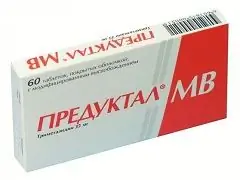- Author Rachel Wainwright [email protected].
- Public 2023-12-15 07:39.
- Last modified 2025-11-02 20:14.
Preductal MB
Preductal MV: instructions for use and reviews
- 1. Release form and composition
- 2. Pharmacological properties
- 3. Indications for use
- 4. Contraindications
- 5. Method of application and dosage
- 6. Side effects
- 7. Overdose
- 8. Special instructions
- 9. Application during pregnancy and lactation
- 10. Use in childhood
- 11. In case of impaired renal function
- 12. For violations of liver function
- 13. Use in the elderly
- 14. Drug interactions
- 15. Analogs
- 16. Terms and conditions of storage
- 17. Terms of dispensing from pharmacies
- 18. Reviews
- 19. Price in pharmacies
Latin name: Preductal MR
ATX code: C01EB15
Active ingredient: trimetazidine (trimetazidine)
Producer: Pharmaceutical Joint Stock Company, Anfarm OA (Pharmaceutical Joint-Stock Company, Anpharm SA) (Poland), Serdix, LLC (Russia); Servier Laboratories (France)
Description and photo update: 2019-20-08
Prices in pharmacies: from 630 rubles.
Buy

Preductal MB is an antianginal drug for improving myocardial metabolism in ischemic conditions.
Release form and composition
Dosage form of Preductal MV - modified release tablets: round, biconvex, covered with a pink film, at the break - white (30 pcs. In blisters, in a cardboard box 2 blisters).
Composition of 1 tablet:
- Active ingredient: trimetazidine dihydrochloride - 0.035 g;
- Auxiliary components: povidone, calcium hydrogen phosphate dihydrate, hypromellose, magnesium stearate, macrogol-6000, colloidal silicon dioxide;
- Film shell: premix No. 5361 dry (dye iron oxide red, titanium dioxide, glycerol, magnesium stearate, hypromellose, macrogol-6000).
Pharmacological properties
Pharmacodynamics
The mechanism of action of trimetazidine is based on preventing a decrease in the intracellular concentration of ATP (adenosine triphosphate) by maintaining the energy metabolism of cells in a state of hypoxia. This ensures the normal functioning of membrane ion channels, maintenance of cellular homeostasis and transmembrane transport of sodium and potassium ions.
Due to the selective inhibition of the enzyme 3-CAT (3-ketoacyl-CoA thiolase), trimetazidine inhibits the oxidation of fatty acids of the mitochondrial long-chain fatty acid isoform. As a result, glucose oxidation increases and glycolysis accelerates with glucose oxidation, which is the basis for protecting the myocardium from ischemia. The pharmacological properties of trimetazidine are based on the switch of energy metabolism from fatty acid oxidation to glucose oxidation.
As a result of the studies carried out, it was found that trimetazidine:
- supports energy metabolism of neurosensory tissues and heart during ischemia;
- reduces the severity of intracellular acidosis and changes in transmembrane ion flux accompanying ischemia;
- reduces the size of myocardial damage;
- reduces the level of migration and infiltration of polynuclear neutrophils in reperfused and ischemic heart tissues.
Trimetazidine has no direct effect on hemodynamic parameters.
Effects of Preductal CF in patients with angina pectoris:
- an increase in coronary reserve, which leads to a slowdown in the onset of ischemia associated with exercise, starting from the fifteenth day of treatment;
- a significant reduction in the frequency of angina attacks and the need for short-acting nitroglycerin;
- limiting the fluctuations in blood pressure associated with physical activity, while the heart rate does not change significantly;
- improvement of the contractile function of the left ventricle against the background of ischemic dysfunction.
The efficacy and safety of using Preductal MV in patients with stable angina pectoris has been proven as monotherapy and in combination with other drugs with antianginal action (in case of insufficient therapeutic effect from their use).
With combined therapy with metoprolol, there was a statistically significant improvement in the results of exercise tests and clinical symptoms compared with placebo. Specifically, this improvement relates to the total duration of exercise tests, total exercise time, time to development of ST-segment depression, time to angina attack, number of angina attacks per week, and short-acting nitrate intake per week.
There are also improvements in performance with the simultaneous use of trimetazidine with atenolol.
Pharmacokinetics
After oral administration, trimetazidine is rapidly absorbed and reaches its maximum plasma concentration in the blood in about 5 hours.
For more than 24 hours, the concentration in the blood plasma remains at a level that significantly exceeds that determined after 11 hours (by 75%). The time to reach an equilibrium state is 60 hours. Food intake has no effect on the bioavailability of trimetazidine.
The volume of distribution of trimetazidine is 4.8 l / kg. This is evidence that the substance is well distributed in tissues. Has a fairly low degree of binding to blood plasma proteins (approximately 16%).
Excretion of trimetazidine occurs mainly by the kidneys, mainly unchanged. In young healthy volunteers, the half-life is 7 hours; in patients over the age of 65, this figure rises to 12 hours.
Renal clearance is directly related to creatinine clearance; hepatic clearance decreases with the patient's age.
In patients over 75 years of age, an increased exposure of trimetazidine is possible, which is associated with an age-related decrease in renal function. As a result of the study, it was found that in severe renal failure (with creatinine clearance less than 30 ml / min), the exposure of the substance in the blood plasma increases 2 times in comparison with patients with creatinine clearance more than 60 ml / min.
Indications for use
According to the instructions, Preductal MV is used for long-term therapy of ischemic heart disease (CHD) in order to prevent attacks of stable angina pectoris as part of a combination treatment or as a monopreparation.
Contraindications
Absolute:
- Severe renal failure (creatinine clearance (CC) <30 ml per minute);
- Parkinson's disease, including its characteristic symptoms - tremor, restless legs syndrome, other movement disorders associated with parkinsonism;
- Pregnancy and breastfeeding period;
- Children and adolescents under the age of 18 (there are no data from clinical studies in the required volume);
- Hypersensitivity to trimetazidine dihydrochloride and other components of the drug.
Relative (Preductal MB is used with caution, the likelihood of side effects is increased):
- Renal failure of moderate severity (CC = 30-60 ml per minute);
- Severe hepatic impairment (limited clinical data);
- Elderly age (over 75 years old).
Instructions for use of Preductal MB: method and dosage
Preductal MV tablets are taken orally whole, without chewing, washed down with water.
The duration of therapy is determined by the attending physician.
The recommended dosage regimen is 1 tablet 2 times a day (morning and evening), simultaneously with a meal. The maximum permissible daily dose is 0.07 g (2 tablets).
For patients with moderate renal dysfunction (CC = 30-60 ml per minute), the daily dose is 0.035 g (1 tablet), in the morning with breakfast.
Due to the age-related decrease in renal function, an increased exposure of trimetazidine can be observed in patients over 75 years old, therefore, the dose of Preductal MB should be selected with caution.
Side effects
- Digestive system: often - diarrhea, dyspepsia, abdominal pain, nausea, vomiting; frequency unknown - constipation;
- Central nervous system (CNS): often - headache, dizziness; the frequency is unknown - sleep disorders (drowsiness, insomnia), symptoms of Parkinson's disease (akinesia, tremor, increased tone), unsteadiness of gait and unsteadiness in the Romberg position, "restless legs" syndrome and other associated movement disorders, usually reversible after trimetazidine withdrawal;
- Skin and subcutaneous fat: often - itching, urticaria, skin rash; frequency unknown - acute angioedema, acute generalized exanthematous pustulosis;
- Cardiovascular system: rarely - extrasystole, palpitations, tachycardia, marked decrease in blood pressure (BP), orthostatic hypotension, accompanied by general weakness, loss of balance or dizziness (especially in the case of simultaneous use of antihypertensive drugs), flushing of the face;
- Hematopoietic system: frequency unknown - thrombocytopenia, agranulocytosis, thrombocytopenic purpura;
- Hepatobiliary system: frequency unknown - hepatitis;
- General reactions: often - asthenia.
Gradation of undesirable side effects arising from the use of Preductal MB: ≥1 / 10 - very often; <1/10 - ≥ 1/100 - often; <1/100-≥1 / 1000 - infrequently; <1/1000-≥1 / 10,000 - rarely; <1/10 000 - very rare; the frequency cannot be calculated from the available data - the frequency is unknown.
Overdose
There is limited information about trimetazidine overdose.
In case of an overdose, symptomatic therapy is indicated.
special instructions
Preductal CF is not indicated for the relief of angina attacks and is not intended for the treatment of myocardial infarction or unstable angina in the initial period before hospitalization or in the first days of hospitalization.
With the development of an attack of angina pectoris, it is necessary to revise the treatment and adapt it (drug therapy or a procedure for myocardial revascularization).
As a result of taking trimetazidine, the appearance or aggravation of symptoms of Parkinson's disease (tremor, akinesia, increased tone) is possible, which requires regular monitoring of patients, especially in old age. In controversial situations, patients need to undergo an appropriate examination by a neurologist.
Preductal MV should be finally canceled in case of the appearance of such movement disorders: instability in the Romberg position, unsteadiness of gait, symptoms of parkinsonism, tremor, “restless legs” syndrome. Such disorders are extremely rare and usually disappear in most patients within 4 months after discontinuation of the drug. If the symptoms of parkinsonism persist for more than 4 months, you should seek the advice of a neurologist.
There have been cases of falling patients, which are associated with "unsteadiness" of gait, instability in the Romberg position, a pronounced decrease in blood pressure, especially when Preductal MV is combined with taking antihypertensive drugs.
Influence on the ability to drive vehicles and complex mechanisms
In the results of clinical studies, the effect of Preductal MV on hemodynamic parameters was not noted, but during post-registration observations episodes of drowsiness and dizziness were recorded. Such conditions can affect the ability to perform work requiring the speed of psychomotor reactions and increased attention, incl. for vehicle management.
Application during pregnancy and lactation
Preductal CF is not prescribed during pregnancy / lactation.
Pediatric use
Preductal CF therapy is contraindicated in patients under 18 years of age, since there is insufficient clinical data on the safety and efficacy of the drug in pediatric practice.
With impaired renal function
- severe renal failure (creatinine clearance <30 ml / min): therapy is contraindicated;
- renal impairment (creatinine clearance 30-60 ml / min): Preductal CF should be used under medical supervision.
For violations of liver function
In case of severe hepatic impairment, Preductal MB should be used under medical supervision.
Use in the elderly
Preductal CF for elderly patients should be administered under medical supervision.
Drug interactions
The interaction of trimetazidine with other drugs / preparations was not observed.
Analogs
Analogues of Preductal MV are: Trimetazidin-Teva, Trimetazid, Angiosil, Precard, Antisten, Trimectal MV, Antisten MV, Trimetazidin MV, Vero-Trimetazidine, Trimetazidin-Biocom MV, Deprenorm MV, Predizin, Preductal OD, Trimekor, Rimecor MV, Trimetazidin MV Trimet, Trimetazidine, Trimetazidine MV-Teva, Trimitard MV.
Terms and conditions of storage
No special storage conditions required. Keep out of the reach of children.
The shelf life is 3 years.
Terms of dispensing from pharmacies
Dispensed by prescription.
Reviews about Preductal MV
Patients reviews about Preductal MV leave mostly positive, indicating that due to its use, loads are easier to transfer, and the quality of life is improved. The drug is often used in combination therapy.
As disadvantages, it is most often noted that Preductal MV has a higher cost in comparison with analogues.
Price for Preductal MB in pharmacies
The approximate price for Preductal MB (60 tablets) is 694-1328 rubles.
Preductal MB: prices in online pharmacies
|
Drug name Price Pharmacy |
|
Preductal MB 35 mg film-coated tablets with modified release 60 pcs. 630 RUB Buy |

Anna Kozlova Medical journalist About the author
Education: Rostov State Medical University, specialty "General Medicine".
Information about the drug is generalized, provided for informational purposes only and does not replace the official instructions. Self-medication is hazardous to health!






